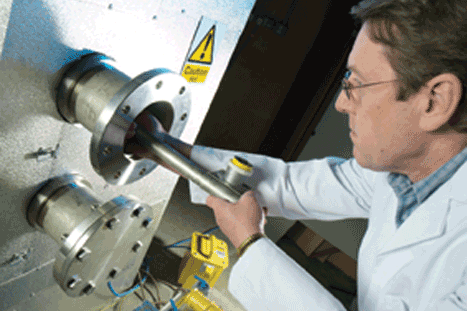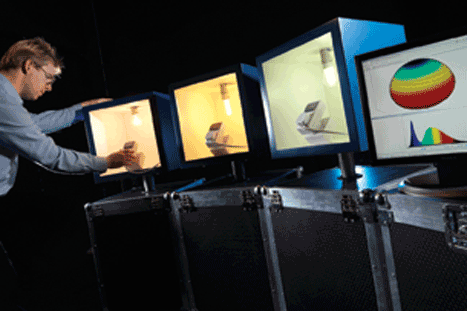How do we know how effective our attempts to reduce emissions really are? Many manufacturers are taking steps to reduce the amount of carbon dioxide (CO2) they produce, even if the main motivation is cutting energy bills. In the UK, we are told that the business sector has reduced its carbon footprint by 30 per cent since 1990, although manufacturing decline probably has something to do with this. But figures such as this aren’t determined by the amount of CO2 actually in the air, but rather are derived from examining energy consumption. And as carbon emissions trading really begins to affect the industrial cost of energy, an accurate account of how much CO2 a company is really producing will become vitally important to businesses and regulators.

This is one of the reasons why the UK’s National Physical Laboratory (NPL) has established the Centre for Carbon Measurement (CCM): to help develop the science and technology to enable accurate, fair and consistent carbon emissions measurement. Alongside this was the aim to improve data on climate change itself through better ground- and satellite-based measurement and data analysis. But bringing all of NPL’s carbon-related work together under the banner of the CCM also meant including its efforts to help low-carbon technology manufacturers test and improve their products.
‘The broad aim of the centre is to bring measurement science to the issues of climate change and the development of a low-carbon economy,’ said Jane Burston, head of the CCM.
‘I think in a lot of the things we do, the measurement is kind of hidden. When you go to the petrol pump, you don’t doubt the amount of petrol the meter says is going into your car; you don’t doubt the quality of the petrol. And what we aim to do is support the provision of regulation by helping climate science be better understood… Then there’s going to be a technology response to that regulation, so how can we make sure that innovators have the measurement science support that they need to develop their technologies and then prove their performance of them to potential investors or customers?’
When you go to the petrol pump, you don’t doubt the amount of petrol the meter says is going into your carJane Burston, CCM
Helping companies at this pre-commercial stage is something NPL is very used to doing, making it well suited to take on the challenges of getting a variety of what can be deemed ‘low-carbon technology’ ready for manufacture. And by including NPL’s existing work on technologies ranging from next-generation organic solar panels to solid-state LED lighting, the centre is able to address wider issues of energy generation and consumption. ‘One of the good things about the Centre for Carbon Measurement is that it can group a lot of these disparate areas under one roof,’ explained Gareth Hinds, the centre’s science leader for low-carbon technology. ‘There is a lot of drive at the moment looking at building performance and energy management in cities. Photovoltaics, solid-state lighting and smart grids are all part of that larger effort.’
One particular area now under the centre’s banner that represents eight years’ worth of work at NPL is that of fuel-cell technology. Fuel cells, especially hydrogen fuel cells, are often seen as a possible way of generating power for both vehicles and larger-scale electricity needs but are currently held back from widespread commercial use by their high cost and low durability and the lack of a refuelling infrastructure. NPL’s scientists are hoping to tackle the second issue of short lifetimes for fuel cells due to the corrosion of their components that occurs over time, with a number of measurement approaches that help to improve the understanding of how this degradation takes place. One of these was a novel reference electrode developed with companies Johnson Matthey and Intelligent Energy under a Technology Strategy Board (TSB)-funded project.
The aim was to find a way to monitor how much corrosion was taking place and how quickly inside the cell. Existing reference electrodes work by providing a known electric potential value that can be compared with that of a working electrode, allowing you to calculate how much corrosion has taken place.
Fuel cells are currently held back from widespread commerical ise by their high cost and low durability
The problem is that reference electrodes attached to a working fuel cell only provide information about the condition of the perimeter of the component being measured. ‘The key to our design is that the reference electrode probes come in through the end plates of the cell so you can map the potential in an array across the active area of each electrode, and that’s never been done before,’ said Hinds.

Another approach developed by NPL is a way of measuring how much of the catalyst material (typically platinum) in the electrode takes part in the reaction, which depends on its structural arrangement within the electrode. ‘The bigger the area of platinum that you have that is active, the more current you can draw from that electrode,’ said Hinds. Corrosion in the electrode reduces this current over time so measuring the output of a fuel cell allows you to work out how much degradation has occurred. But as working devices are made up of stacks of individual cells, NPL devised a way to calculate the area of each one based on the electric potential of each cell — something that is already measured by the stack’s control software.
These examples show how the CCM is not only working on specific projects to improve manufacturers’ technology but also developing tools and standards that the low-carbon sector can use.
‘That’s very much the NPL model in that we receive government funding to improve generic measurement tools and models, and then we use these commercially, either in collaborative research with partners or in contract work,’ said Hinds.
‘We’re passed the early stage [of technology readiness] but not in the mature stage — we’re just in that area between where we’re still developing new techniques and they’re starting to be applied in industry.’ Perfect for a sector full of small companies with limited cash, working on immature technologies.
In-depth
EADS Astrium is leading a project for more accurate measurement of greenhouse gases
When the UK and other countries report how much CO2 they are pumping into the atmosphere — using something called a carbon inventory — they rely on accounts from individual emitters of their industrial activities. But NPL is involved in a new project led by space company EADS Astrium that aims to develop a way of measuring more precisely the amount of greenhouse gases in the atmosphere.
‘This service will improve that approach by making physical measurements and then integrating that into the modelling used to assimilate and produce a figure for countrywide emissions and make that more accurate,’ said Melanie Williams, leader of NPL’s environmental measurement group.
As part of a pilot scheme, the Centre for Carbon Measurement is setting up four sensors supplied by Picarro at elevated points across London to measure the amount of CO2 and methane in the city’s air. NPL will also provide the calibration standards — essentially small known quantities of gas — used to make sure the sensors’ readings are accurate, and then collect and manage the data, not just from the fixed stations but also from equipment mounted on a vehicle that will tour the capital promoting the project.
‘The data quality is very important when you’re looking for small changes over a number of years, as you would do in climate-change studies, so we’ll be producing the highest-quality calibration gas standards and using those to do the calibrations in the field,’ said Williams.
And as the scheme will continue over the entire summer, it may even reveal what effect the Olympics will have on London’s atmosphere.




April 1886: the Brunkebergs tunnel
First ever example of a ground source heat pump?